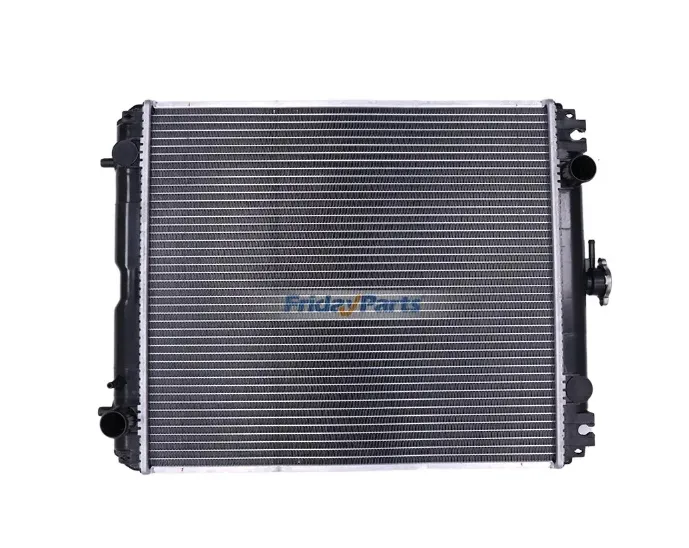The engine radiator plays a great role in heavy equipment, especially in hot weather. Once it fails, it can cause sudden overheating while working, increasing the risk of accidents. This article provides you with complete information about engine radiators, including signs of failure and maintenance tips, to prevent problems before they occur.
What Is a Radiator?
A radiator for heavy equipment is a type of heat exchanger that transfers thermal energy from one medium to another for the purpose of cooling and heating. It is used in heavy equipment such as construction machinery, mining equipment, and agricultural machinery to keep their engines cool and running smoothly. Radiators help prevent overheating and engine damage by transferring heat away from the engine.

How does a Radiator Work in Heavy Equipment?
In heavy equipment, it works by transferring heat from the engine to another medium, usually air or coolant, through a process called convection. The hot coolant from the engine flows through the tubes of the radiator, where it is cooled by the air passing over the fins. The cooled coolant then flows back into the engine to absorb more heat. This cycle continues to keep the engine at a safe operating temperature.
What are the Bad Radiator Symptoms?
- Overheating engine: If the engine is consistently running hot or overheating, it could be a sign that the radiator is not effectively cooling the engine.
- Coolant leaks: If you notice coolant leaking from the it or under the heavy equipment, it could be a sign of a damaged or corroded radiator.
- Low coolant levels: If the coolant level is consistently low, even after topping it off, it could be a sign of a leak in the radiator or cooling system.
- Discolored or contaminated coolant: If the coolant appears discolored or contaminated with debris, it could be a sign that the radiator is corroded or damaged.
If you notice any of these symptoms, it’s important to inspect and repair or replace as necessary to prevent further damage to your heavy equipment.
When to Seek Professional Help?
If you find any of the following signs in the radiator, you can seek help from a professional off-road machinery repair service.
Visible leaks: Leaks may occur under your excavator or anywhere in the radiator system. A professional mechanic can identify and repair the source of the leak.
Engine upgrades: The mechanic will provide you with suggestions based on the upgrade to ensure that the radiator can withstand the increased heat.
The level is still low after filling the coolant: Tell the technician about this situation; there may be problems elsewhere.
Continued overheating: Coolant level is normal and there are no leaks, but it continues to overheat. Please do not hesitate to ask a professional for help.
Rust or corrosion: When you are unsure whether a large amount of rust or corrosion on the radiator will affect the normal operation of the engine, follow the professional’s advice to replace or repair it.
Use time: Long-term use (such as about 10 years) may not cause any problems at the moment, but it’s wise to have a professional mechanic do a comprehensive inspection.
How to Choose a Good Radiator?
When choosing a new one for your excavator or other equipment, there are several factors to consider:
-
Compatibility
Make sure it is compatible with your specific make and model of heavy equipment.
-
Cooling capacity
Choose a radiator with a cooling capacity that matches the heat output of your engine.
-
Durability
Look for a radiator made from durable materials that can withstand the harsh conditions of heavy equipment operation.
-
Ease of maintenance
Choose a radiator that is easy to access and maintain to ensure optimal performance.
It’s also a good idea to consult with the supplier or a qualified technician to ensure you choose the right parts for your heavy equipment.
Importantly, choose a reliable supplier that offers a warranty and responsive customer service, especially for demanding work environments. FridayParts provides a one-year warranty and a 90-day return, so you can get it with confidence.
How to Clean a Radiator in Heavy Equipment?
- Turn off the engine: Make sure the engine is turned off and cool before attempting to clean.
- Remove debris: Use a soft brush or compressed air to remove any debris, such as leaves or dirt, from the exterior of the radiator.
- Flush the radiator: Drain the old coolant from it and use a flush solution to clean the inside. Follow the instructions on the flush solution and make sure to flush the radiator thoroughly with water afterwards.
- Refill with fresh coolant: Refill the radiator with fresh coolant according to the manufacturer’s specifications.
It’s important to regularly clean and maintain your radiator to ensure optimal performance and prevent overheating. Consult your heavy equipment’s owner’s manual for specific instructions and recommended maintenance intervals.
Conclusion
In conclusion, with temperatures on the rise, it’s essential to regularly check and replace your engine components to ensure optimal performance. If you’re in need of a new replacement, now is the perfect time to buy one. FridayParts is currently holding a sale on cooling systems, offering great deals on high-quality radiators. Ready to replace or upgrade it for your engine? Browse our radiator catalog to find the best price for your needs.
